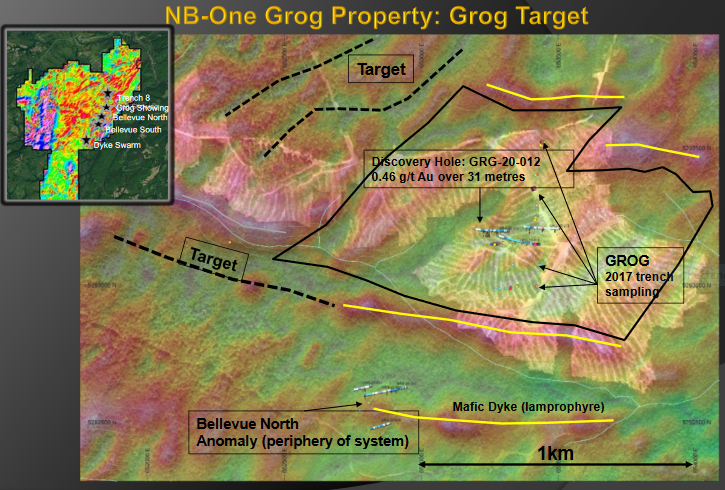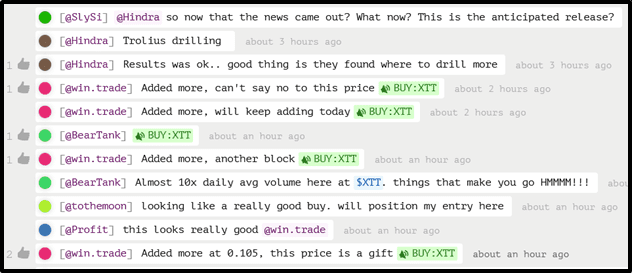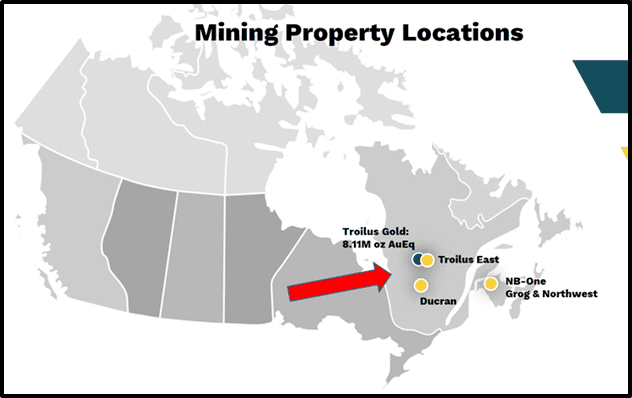On February 17, 2021 X-Terra Resources (XTT.V) provided the results of the fall 2020 Grog drilling program in Northeastern New Brunswick, Canada.
At a macro level, this was not a cheery day for gold bugs.
“Gold futures prices are sharply down and hit an eight-month low in midday U.S. trading Wednesday [$1,775 USD]. A stronger U.S. dollar index on this day and a deteriorating near-term technical posture in gold emboldened the sellers in the yellow metal today,” stated Kitco News.
“Bitcoin hit another record high Wednesday and traded well above $50,000,” added Kitco, “The keener investor interest in Bitcoin and other crypto currencies could be taking away some of the allure for historical safe-haven assets gold and silver”.
The primary objective of XTT’s drill program was to begin defining the geometry and extension of the Grog showing and to identify new peripheral mineralization zones toward the definition of a large epithermal gold system.
“The target at Grog is a large intrusion-related epithermal system,” reported Equity Guru’s Greg Nolan on December 18, 2020.
“An 11-hole drill program conducted earlier this year yielded a new discovery in hole GRG-20-012: 0.41 g/t Au over 36 meters (including 0.46 g/t Au over 31 meters and 7.59 g/t Au over 0.6 meters) at a vertical depth of 81 meters,” added Nolan.

Prior to this drill program the company has carried out exploration activities that support the presence of a large epithermal gold system on the Grog project.
Data integration and modelling were completed using geophysical patterns generated by magnetic and IP surveys. A geochemical sampling program completed prior to this drill program outlined a two-square-kilometre arsenic anomaly which can indicate the presence of gold.
“The drill program was completed following an east-west grid to follow up on the primary gold and arsenic soil anomalies which overlay important structural trends,” states XTT, “The drilling grid covered approximately one kilometre from north to south while using a minimum step-out space of 50 metres where appropriate. The holes reached vertical depths ranging from 115 metres to 180 metres”.
GRG-20-29 returned the longest gold-bearing intercept on the Grog project to date.
The gold mineralization can now be correlated to visual observations such as the density of fractures, faults zones and the presence of areas where disseminated sulphides occur.
“It is becoming clear that the gold zone is closely associated with a carbonate and clay altered sandstone,” stated XTT, “Alteration is the result of hydrothermal stockwork and brecciation that have been reworked by regional deformation. The mineralized zones are characterized by open space filling of quartz-carbonate. Sulphides, mainly pyrite and arsenopyrite, are abundant, taking the form of both disseminated and replacement of host rocks. In addition, some narrow veins of stibnite have been observed”.
“This is a big step forward in our understanding of the Grog mineralized system,” stated Michael Ferreira, president and CEO of X-Terra, “With the new information gained, our geological team has a clearer understanding of the mineralization trends.”
“We are now actively modelling these trends to generate higher probability targets of higher grade mineralization,” added Ferreira, “To date there has only been 19 drill holes at the Grog target, including 16 from this program. The identification of a second wide gold-bearing interval at this early stage reinforces the confidence that a large epithermal gold system is present on the Grog project.
“Additionally, we would like to thank our shareholders for their patience during the long turnaround time for these results. Labs continue to be overwhelmed by the volume of samples from a busy industry along with the ongoing complications brought on by the COVID-19 pandemic.
“X-Terra also wants to report that upon reception of these results, our systematic sampling of non-mineralized rock has identified multiple zones grading up to 2.19 g/t Au which have not been sampled on either side along the hole. These samples are currently being cut and will be sent to the lab as soon as they are ready.”
After the February 17, 2021 news, XTT stock was up 5% to .105 and then it was halted.
Investors on the vibrant bull-board at CEO.ca were mostly bullish on XTT.

Grog is not XTT’s only iron in the fire.
On August 13, 2020 XTT announced the identification of a new mineralized system close to the Troilus Mine, in Northern Québec, from its first ever prospecting campaign on the property (see X-Terra press release dated July 2, 2020).

“The newly identified “Smoke” showing is located in the southwest portion of the property three kilometres directly south east of the former Troilus open pit,” reported XTT.

“The new system identified covers a strike length of approximately 2.2 kilometres where polymetallic sulfides were sampled.
Sporadic samples over this area returned copper grades up to 0.25% Cu, silver grades up to 8.0 g/t Ag, zinc grades up to0.7% Zn and 0.11 g/t Au.”
Note: at press time XTT stock is still halted, pending news.
Full Disclosure: XTT is an Equity Guru marketing client.


Leave a Reply